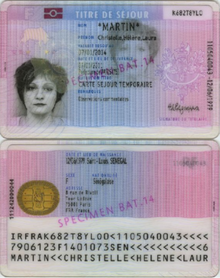
Back الهجرة إلى فرنسا Arabic Inmigración en Francia Spanish Immigration en France French Иммиграция во Францию Russian Імміграція до Франції Ukrainian Immigration to France Uzbek




According to the French National Institute of Statistics INSEE, the 2021 census counted nearly 7 million immigrants (foreign-born people) in France, representing 10.3% of the total population. This is a decrease from INSEE statistics in 2018 in which there were 9 million immigrants (foreign-born people) in France, which at the time represented 14% of the country's total population.[1]
The area with the largest proportion of immigrants is the Parisian urban area (Greater Paris), where almost 40% of immigrants lived in 2012.[2] Other regions with important immigrant populations are Rhône-Alpes (Lyon) and Provence-Alpes-Côte d'Azur (Marseille).
The Paris region is a magnet for immigrants, hosting one of the largest concentrations of immigrants in Europe. As of 2006, about 45% of people (6 million) living in the region were either immigrant (25%) or born to at least one immigrant parent (20%).[3]
Among the 802,000 newborns in metropolitan France in 2010, 27.3% had one or both parents foreign-born, and about one quarter (23.9%) had one parent or both born outside of Europe.[4][5] Including grandparents, about 22% of newborns in France between 2006 and 2008 had at least one foreign-born grandparent (9% born in another European country, 8% born in Maghreb and 2% born in another region of the world).[6]
In 2014, the National Institute of Statistics (INSEE) published a study reporting that the number of Spanish, Portuguese, and Italian immigrants in France between 2009 and 2012 has doubled. This increase resulting from the financial crisis that hit several European countries in that period, has pushed up the number of Europeans settled in France.[7] Statistics on Spanish immigrants in France show a growth of 107 percent between 2009 and 2012, i.e. in this period went from 5,300 to 11,000 people.[7][8]
Of the total of 229,000 new foreigners coming to France in 2012, nearly 8% were Portuguese, British 5%, Spanish 5%, Italians 4%, Germans 4%, Romanians 3%, and Belgians 3%.[7]
By 2022, the total number of new foreigners coming to France rose above 320,000 for the first time, with nearly a majority coming from Africa. A significant increase in students, family reunification and labor migration occurred under the presidency of Emmanuel Macron.[9]
- ^ "Immigrant and Foreign Population in France". insee.fr. 2023-04-24. Archived from the original on 2023-07-05. Retrieved 2023-04-24.
- ^ "La localisation géographique des immigrés - Insee Première - 1591". www.insee.fr (in French). Archived from the original on 2018-09-19. Retrieved 2018-03-31.
- ^ Les descendants d'immigrés vivant en Île-de-France Archived 2011-10-28 at the Wayback Machine, IAU Idf, Note rapide Société, n° 531
- ^ Naissances selon le pays de naissance des parents 2010 Archived 2013-09-27 at the Wayback Machine, Insee, septembre 2011
- ^ Parents born in overseas territories are considered as born in France.
- ^ Les immigrés, les descendants d'immigrés et leurs enfants Archived 2012-07-08 at the Wayback Machine, Pascale Breuil-Genier, Catherine Borrel, Bertrand Lhommeau, Insee 2011
- ^ a b c "Qui sont les nouveaux immigrés qui vivent en France ?". sudouest.fr (in French). 12 February 2014. Archived from the original on 17 July 2016. Retrieved 26 June 2015.
- ^ "El número de inmigrantes españoles en Francia se ha duplicado con la crisis" (in Spanish). 20minutos.es. 28 November 2014. Archived from the original on 26 June 2015. Retrieved 26 June 2015.
- ^ "Immigration rose in France in 2022, driven by labor needs and foreign students". Le Monde.fr. 2023-01-27. Archived from the original on 2023-07-13. Retrieved 2023-07-13.
© MMXXIII Rich X Search. We shall prevail. All rights reserved. Rich X Search